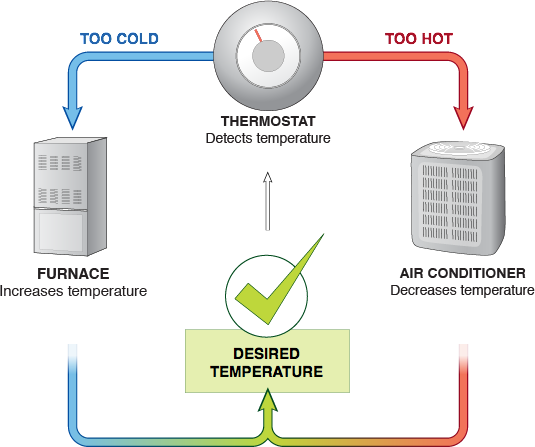Homeostasis is the body’s use of physical and chemical processes to maintain a consistent internal environment. Regulating the internal environment is essential for the body to function properly, and feedback cycles play a key role in this process. Let’s examine the components of a generalized feedback cycle.
NEXT
A typical feedback loop consists of several components:
detect a change in the internal environment and trigger structures called
to oppose or reduce the change, returning the organism to the
— a target value or range.
effectors
inhibitors
sensors
set point
stimulus

sensor
set point
effector
How does each cycle respond to a change in conditions?
feedback cycles enhance or intensify the change and move the
system further away from the set point.
feedback cycles counteract or reverse the change and move the
system back towards the set point.
Positive
Negative
When does each cycle end?
feedback cycles end when the system is restored to
“normal” conditions.
feedback cycles end when the initial stimulus
triggering the response is removed.
Positive
Negative
As labor begins, the uterus contracts and pushes the baby against the cervix. Stretch receptors in the cervix respond by signaling to the mother’s brain to produce the hormone oxytocin. The oxytocin stimulates more uterine contractions, which starts the cycle all over again. The process continues until the baby emerges from the vagina and the stretch receptors are no longer stimulated.
After eating a large meal, your blood glucose levels increase. The increase is detected by cells in the pancreas, which triggers the release of insulin. Insulin stimulates body cells and the liver to take up glucose from the bloodstream, thus bringing blood glucose back down to normal levels.
If you have been fasting or exercising vigorously without eating, your blood glucose levels may decrease. Cells in the pancreas detect low blood glucose levels and respond by releasing glucagon. Glucagon causes the liver to convert stored glycogen into glucose, which is released into the bloodstream, thus raising blood glucose to normal levels.
During the rising phase of an action potential, a change in membrane potential causes specialized sodium channels to open. Sodium ions flow into the neuron through these open channels, which further raises the membrane potential and starts the cycle all over again. This process continues until the sodium channels inactivate and no longer allow sodium to move into the cell.
At high altitudes, atmospheric pressure is lower, and less oxygen enters the body. Cells in the kidneys respond to the lower than normal blood oxygen levels by producing the hormone erythropoietin, which stimulates the bone marrow to produce more red blood cells. The additional red blood cells increase the oxygen carrying capacity of the blood and return blood oxygen levels to within a normal range.